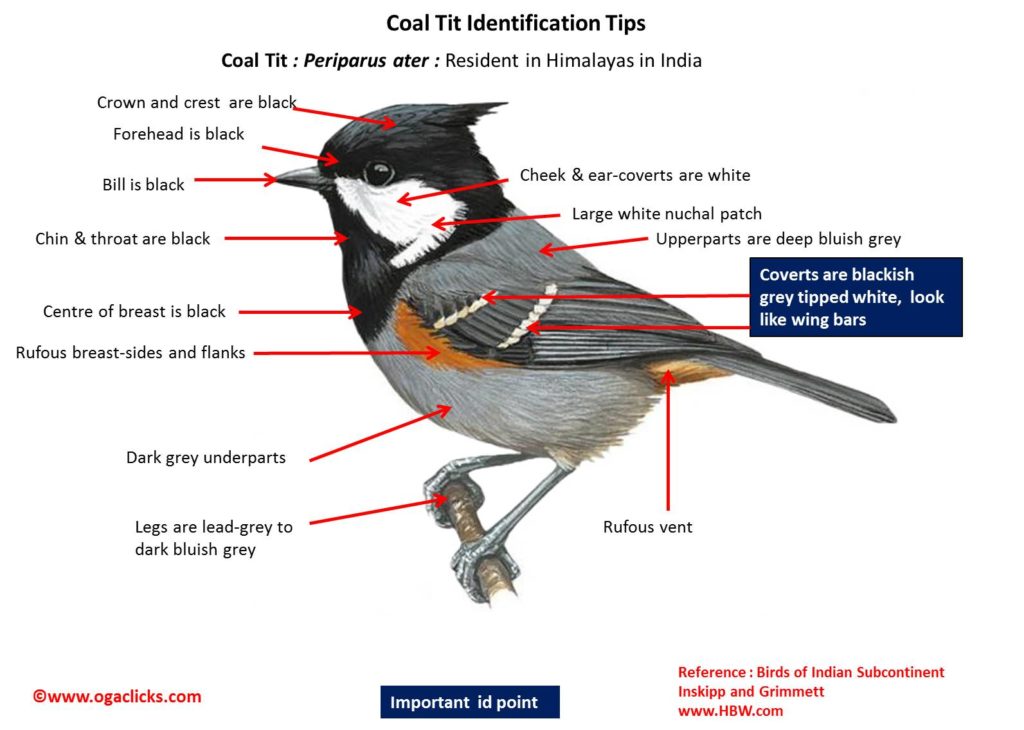Coal Tit

Coal Tit Periparus ater
Etymology :
- Periparus : Greek word peri – very, all around; genus Parus-
- Ater: Latin word for Black
Vernacular Names: Kash: Pintsakon, Tajdar tsar
Distribution in India: Resident of Himalayas in India
Description: Size of 10–12 cm; wt. of 7·2–12 g. It is a small, slim-billed, black-crowned tit (some races are crested) with greyish upperparts and two wingbars. The male nominate race has black forehead, crown and nape and a large white nuchal patch. The cheek and ear-coverts are white. The upperparts are deep bluish-grey, tinged lightly olive-brown, more prominently brown to olive on rump and uppertail-coverts. The tail is dark grey-brown. All feathers are finely fringed paler or greyish-olive; upperwing-coverts are blackish-grey, broadly fringed bluish-grey, the tips of median and greater coverts are white, the alula and primary coverts are blackish, the latter fringed finely blue-grey. The flight-feathers are grey-brown, tertials are finely fringed greyer and broadly tipped white, secondaries and primaries are finely fringed grey or olive-grey, inner secondaries are finely tipped white. The chin and throat to side of upper breast are black, breast and belly are white, flanks to vent and undertail-coverts are greyish to light cinnamon-buff. The axillaries and underwing-coverts are light buffish-white. In worn plumage, white nuchal patch can show some dark bases, upperparts duller or darker bluish-grey, pale fringes and tips of wing-coverts are abraded and greyer, edges of flight-feathers are worn or abraded, cheeks dingier, underparts also duller, dirty white on breast and belly and greyish-buff on flanks to vent. The iris is brown or dark brown; bill is black, paler grey sides; legs lead-grey to dark bluish-grey. The female is similar to male but female has a slightly less glossy crown, mantle and scapulars a shade more greenish, wing-coverts duller or fringed greyer, and chin to upper breast brownish-black.
Habitat: It is found in conifer forests and mixed forest. In non-breeding season it is found in similar habitat, but also more frequently in deciduous woodland, parks and gardens. It can be seen from sea level to 4500 m.
Food habits: It eats adult and larval bugs, beetles, lacewings, flies, caddis flies, moths , damselflies, bush-crickets , bees and wasps ,ants , spiders , harvestmen, mites, millipedes , centipedes, slugs and small molluscs, and small earthworms .It also eatsseeds, buds and catkins and sap. The seeds and hard-shelled insects are rapidly and repeatedly stabbed with bill to remove outer husk or shell before softer parts eaten or taken for storage. It also holds seeds in foot while tearing off outer layer. It stores food, like seeds and invertebrates between Jun and Dec in lichen and bark crevices and holes in upper parts of trees and in base of hedges or holes in ground. The cached food is utilized in times of hard winter weather. It occurs alone, in pairs or in loose groups of pairs, and in non-breeding season highly social and often in fairly large groups .It also joins mixed-species foraging flocks, which frequently include Grey-crested Tit, Rufus-crested Tit, Eurasian Treecreeper Goldcrest and leaf-warblers. It actively and acrobatically forages mostly in upper levels of conifer trees, often perching on or hanging from cones and vertical needle clumps while extracting seeds with its fine bill. It also flutters and hovers while gleaning insects from the outside of foliage. In deciduous trees more it often examines branches, twigs and leaves (including undersides) for concealed insects. It may also climb trunk vertically, and pursue slow-flying insects in flight. It frequently forages on ground, usually for fallen seeds and fruits of beech, sweet chestnut and oak. On snow-covered ground may forage in areas exposed by squirrels and wild pigs.
Breeding habits: They breed in Mar to Jul in Himalayas. They are territorial. The Pair formation and display involve prolonged periods of wing-shivering and wheezing calls and slow gliding flight by male, with wings and tail fully spread, passing close to partner, followed by lengthy courtship feeding. The nest is built by female alone. The nest is cup-shaped, made almost entirely of moss, some animal hair, wool and some feathers incorporated. The nest is placed in a hole or cavity with very narrow entrance in tree trunk or old stump. This includes abandoned hole of rodent or woodpecker, in a hole or crevice in wall or rocks, in ground under stones, among roots of fallen tree or in a mouse hole. The holes in trees not usually excavated by pair but may be enlarged. They lay a clutch 5–13 eggs. The incubation is done by female for a period of 14–16 days. The chicks are brooded by female, fed by both parents. The nestling period is18–22 days. The newly fledged young remain together in thick cover for first few days out of nest.